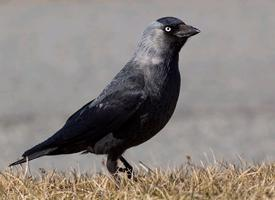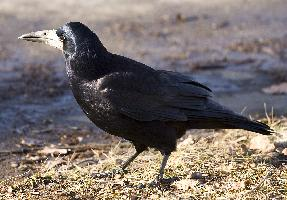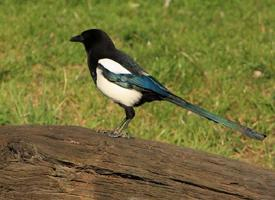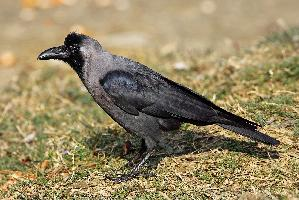
Poids et mesures
| Longueur | de 34 à 39 cm |
|---|---|
| Poids | de 220 à 270 g |
| Envergure des ailes | de 67 à 74 cm |
Description de l'animal
The Western jackdaw (Coloeus monedula), also known simply as the jackdaw, is a captivating bird species that belongs to the crow family, Corvidae. This bird is renowned for its distinctive appearance, high intelligence, and complex social behaviors. Native to Europe, western Asia, and North Africa, the Western jackdaw has adapted well to a variety of habitats, including open woodlands, coastal cliffs, and urban areas, showcasing its remarkable versatility and resilience.Physically, the Western jackdaw is a relatively small member of the crow family, measuring about 34–39 cm in length, with a wingspan of 64–73 cm. One of its most striking features is its silvery-black plumage, which gleams with an iridescent sheen in the sunlight. The bird's head, throat, and upper chest are adorned with a lighter grey color, creating a striking contrast that makes it easily identifiable. Another distinctive characteristic is its eyes; the adult jackdaw has pale, almost silvery eyes, which stand out against its darker facial features, giving it a unique and somewhat enigmatic appearance.
Jackdaws are highly social creatures and are rarely seen alone. They form strong, monogamous pair bonds and are known to engage in complex social interactions within their communities. These birds communicate using a wide range of vocalizations, from a soft, musical 'kaw' to more excited, high-pitched calls when alarmed or in flight. Their intelligence is evident in their problem-solving abilities and their use of tools, a trait shared with other members of the Corvidae family.
The diet of the Western jackdaw is omnivorous and varied, consisting of insects, small rodents, seeds, fruits, and even food waste in urban environments. This adaptability in feeding habits has allowed them to thrive in a wide range of conditions. During the breeding season, which typically begins in April, jackdaws exhibit remarkable nest-building behaviors. They prefer to nest in cavities, such as hollow trees, cliff crevices, and even chimneys or buildings in urban areas. Both the male and female participate in constructing the nest, which they line with hair, wool, and other soft materials to provide a comfortable environment for their eggs and chicks.
The social structure of jackdaw communities is fascinating. They exhibit a hierarchical order, with dominant pairs often leading the group. These birds are known for their playful behavior, engaging in aerial acrobatics, and even playing games with each other, further highlighting their intelligent and curious nature.
In folklore and literature, the Western jackdaw has been a symbol of thievery and trickery, likely due to its curious and sometimes mischievous behavior. However, this reputation belies the bird's significant role in ecosystems as a scavenger and predator of agricultural pests, highlighting its importance in maintaining ecological balance.
Despite facing threats from habitat loss and pollution, the Western jackdaw has shown remarkable resilience. Its ability to adapt to changing environments, along with its widespread range, has helped ensure its survival. As a species of least concern on the IUCN Red List, the Western jackdaw stands as a testament to the adaptability and resilience of nature, captivating the imagination of bird watchers, nature enthusiasts, and scientists alike.
Carte de répartition

Animaux similaires
Nouvelles photos d'animaux
Top 10 des animaux
- Dolphin gull (Leucophaeus scoresbii)
- Diana monkey (Cercopithecus diana)
- Moustached guenon (Cercopithecus cephus)
- Galápagos tortoise (Geochelone nigra complex)
- Japanese macaque (Macaca fuscata)
- Russian tortoise (Testudo horsfieldii)
- Stone loach (Barbatula barbatula)
- Greek tortoise (Testudo graeca)
- Common flying dragon (Draco volans)
- Vendace (Coregonus albula)


